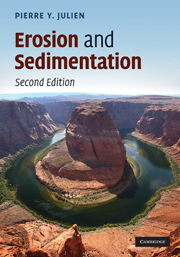Book contents
- Frontmatter
- Contents
- Preface
- List of Symbols
- 1 Introduction
- 2 Physical properties and dimensional analysis
- 3 Mechanics of sediment-laden flows
- 4 Particle motion in inviscid fluids
- 5 Particle motion in Newtonian fluids
- 6 Turbulent velocity profiles
- 7 Incipient motion
- 8 Bedforms
- 9 Bedload
- 10 Suspended load
- 11 Total load
- 12 Reservoir sedimentation
- Appendix A Einstein's Sediment Transport Method
- Appendix B Useful mathematical relationships
- Bibliography
- Index
11 - Total load
Published online by Cambridge University Press: 05 June 2012
- Frontmatter
- Contents
- Preface
- List of Symbols
- 1 Introduction
- 2 Physical properties and dimensional analysis
- 3 Mechanics of sediment-laden flows
- 4 Particle motion in inviscid fluids
- 5 Particle motion in Newtonian fluids
- 6 Turbulent velocity profiles
- 7 Incipient motion
- 8 Bedforms
- 9 Bedload
- 10 Suspended load
- 11 Total load
- 12 Reservoir sedimentation
- Appendix A Einstein's Sediment Transport Method
- Appendix B Useful mathematical relationships
- Bibliography
- Index
Summary
This chapter describes methods to estimate the total sediment load of a river. In Section 11.1, several sediment transport formulas commonly used in engineering practice are presented with detailed calculation examples. Section 11.2 discusses sediment-rating curves; Section 11.3 covers short- and long-term sediment load. Section 11.4 focuses on sediment sources and sediment yield from upland areas. This chapter includes three case studies of capacity- and supply-limited sediment transport.
Every sediment particle which passes a given stream cross-section must satisfy the following two conditions: (1) it must have been eroded somewhere in the watershed above the cross-section; and (2) it must be transported by the flow from the place of erosion to the cross-section. To his statement, Einstein (1964) added that each of these two conditions may limit the rate of sediment transport depending on the relative magnitude of the two controls: (1) the transporting capacity of the stream; and (2) the availability of material in the watershed. The amount of material transported in a stream therefore depends on two groups of variables: (1) those governing the sediment transport capacity of the stream such as channel geometry, width, depth, shape, wetted perimeter, alignment, slope, vegetation, roughness, velocity distribution, tractive force, turbulence, and uniformity of discharge; and (2) those reflecting the quality and quantity of material made available for transport by the stream including watershed topography, geology, magnitude-intensity-duration of rainfall and snowmelt, weathering, vegetation, cultivation, grazing and land use, soil type, particle size, shape, specific gravity, resistance to wear, settling velocity, mineralogy, cohesion, surface erosion, bank cutting, and sediment supply from tributaries.
- Type
- Chapter
- Information
- Erosion and Sedimentation , pp. 264 - 318Publisher: Cambridge University PressPrint publication year: 2010

